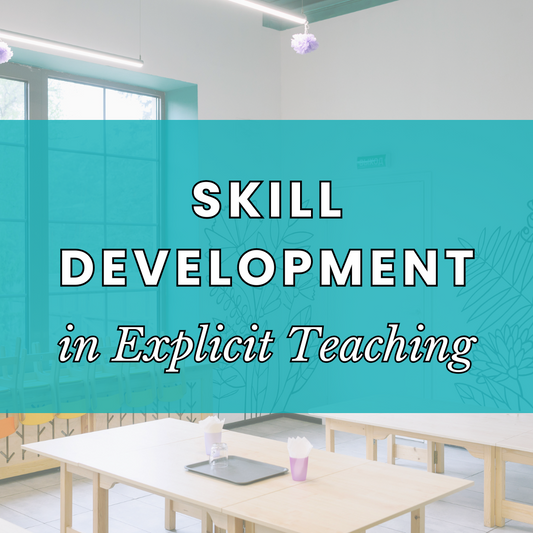
Engagement in Explicit Teaching Lessons: Tips for Delivery
Share
Explicit teaching is all about clear instruction, guided practice, and frequent checking for understanding. However, even the most well-planned lesson can fall flat if students aren’t engaged. The secret? Keep them actively involved every step of the way. In this blog, we’ll explore delivery skills and techniques designed to boost engagement in your explicit teaching lessons, ensuring students stay focused and motivated.
1. Teach, Then Pause for Active Engagement in Explicit Teaching
In explicit teaching, delivering content is step one—but don’t let it become a lecture. Break your instruction into short, focused chunks (5–7 minutes max). After each chunk:
- Ask a question: Pose an open-ended or recall question to check for understanding.
- Use think-pair-share: Have students briefly discuss their thoughts with a partner to reinforce key points.
Example:
After teaching a maths strategy, ask:
“Turn to your partner and explain how you would solve this problem using the strategy we just learned.”
This approach not only encourages participation but also strengthens peer-to-peer learning.
2. Call on Non-Volunteers
While it’s tempting to rely on the same eager hands, engaging all students requires a more inclusive approach. Use techniques to randomly select students, such as:
- Name sticks (write students’ names on craft sticks and pull them from a jar).
- Digital tools like Wheel of Names or ClassDojo.
- Seating patterns (e.g., “I’ll ask someone from this row”).
Why This Works:
Calling on non-volunteers keeps everyone accountable and attentive, knowing they might be asked to share their understanding.
3. Use Guided Practice: "I Do, We Do, You Do"
The hallmark of explicit teaching, “I Do, We Do, You Do,” ensures students transition smoothly from instruction to independent mastery:
- I Do: Demonstrate the skill while thinking aloud.
- We Do: Guide students through the process together, asking questions and clarifying misconceptions.
- You Do: Let students try it on their own, providing immediate feedback.
Engagement Tip:
During the "We Do" phase, involve students by asking for their input at every step. For example, “What should I do next?” or “Can someone point out where I made a mistake?”
4. Engage Students Every 5 Minutes
Give students something to do! Students are more engaged when they’re actively involved in the lesson. Incorporate activities or checkpoints every five minutes:
- Quick pair-share discussions to process new information.
- Hands-on tasks like filling in a graphic organiser or solving a problem together.
- Mini whiteboards: Have students write answers and hold them up for quick feedback.
Example:
In a reading comprehension lesson, after teaching how to identify the main idea, ask students to write the main idea of a short paragraph on their mini whiteboards.
5. Provide Immediate Feedback for Engagement
Feedback is critical in explicit teaching, but timing is everything. Make it instant and actionable to keep students on track:
- During guided practice: Correct errors in real-time with constructive feedback.
- Peer feedback: Teach students to give each other specific, positive suggestions.
Example:
While students are solving problems in pairs, circulate the room, observe their work, and provide individualised support or praise:
“Great job identifying the equation. Now, what’s the next step?”
6. Ask the Right Questions
Questioning is a powerful tool to keep students engaged. Use a mix of:
- Low-level questions: To reinforce basic recall (e.g., “What is the formula for area?”).
- Higher-order questions: To promote critical thinking (e.g., “Why does this method work better than the other?”).
Pro Tip:
Use a wait time of 3–5 seconds after asking a question to give all students time to think before answering.
7. Use Pair-Share Effectively
Pair-share isn’t just a time-filler—it’s an engagement strategy when used with purpose.
- Before pair-sharing: Teach students how to discuss effectively (e.g., taking turns, staying on topic).
- Give clear directions: Provide a specific prompt, such as, “Discuss the three main points of today’s lesson and decide which is most important.”
Student Engagement Boost:
After pair-sharing, randomly call on a few pairs to share their thoughts with the whole class.
8. Make Your Feedback Visible
In explicit teaching, showing the thought process is just as important as explaining it. Use visual tools:
- Write answers or worked examples on the whiteboard.
- Model corrections, strategies or give verbal feedback in front of the whole class.
- Display student work (with permission) to highlight successful approaches.
9. Keep Students Accountable
To ensure student engagement doesn’t wane during explicit teaching, build accountability into your lessons:
- Frequent check-ins: “Thumbs up if you understand so far.”
- Exit tickets: Before students leave, have them answer a short question that reflects the day’s learning.
- Group roles: Assign specific tasks during group work, such as a scribe, speaker, or timekeeper.
Final Thoughts: Engagement in Explicit Teaching Is Active Participation
In explicit teaching, student engagement is the key to success. By keeping your delivery interactive, structured, and responsive, you’ll create a classroom environment where students are motivated to learn and confident in their abilities.
Remember, engagement is about more than enthusiasm—it’s about actively involving students in their own learning process. Teach, ask, share, and adjust, and watch your classroom come to life.



